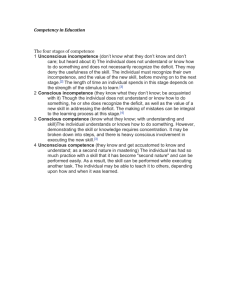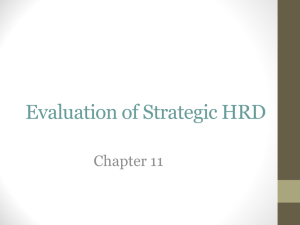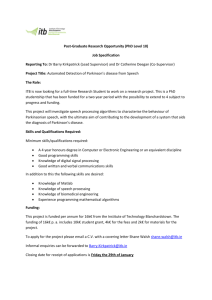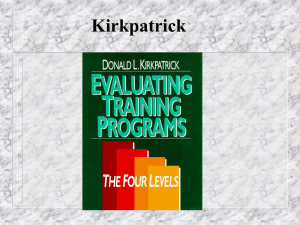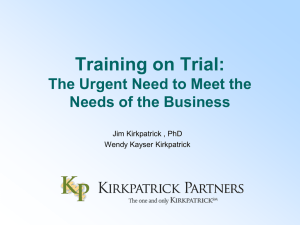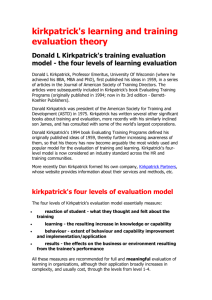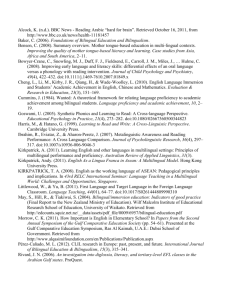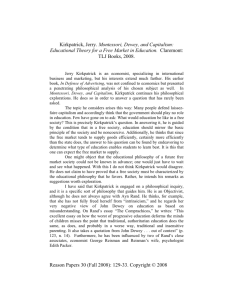Measuring Reaction, Learning, Behavior and Results Behavior, and
advertisement
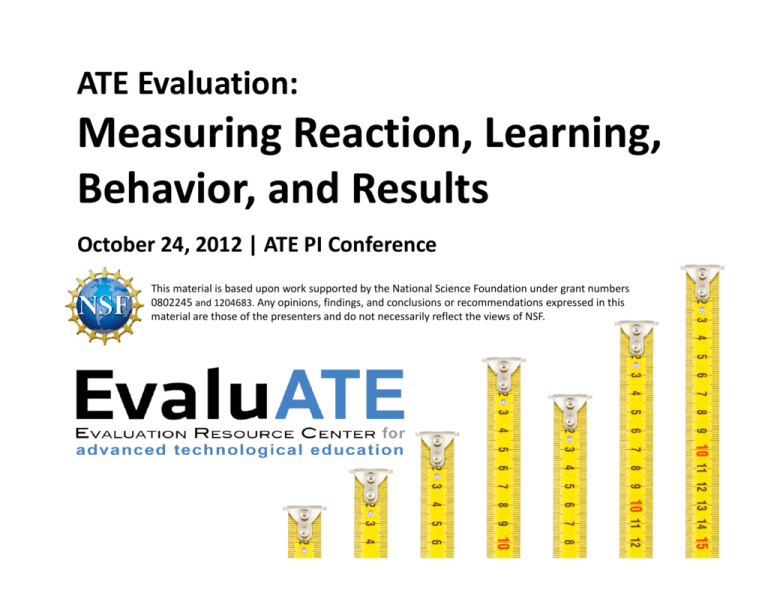
ATE Evaluation: Measuring Reaction, Learning, Behavior and Results Behavior, and Results October 24, 2012 | ATE PI Conference This material is based upon work supported by the National Science Foundation under grant numbers 0802245 and 1204683. Any opinions, findings, and conclusions or recommendations expressed in this material are those of the presenters and do not necessarily reflect the views of NSF. Overview Evaluation fundamentals Evaluation fundamentals Kirkpatrick Model for evaluation Data collection Applying Kirkpatrick Data quality Data quality Data Interpretation Evaluation l i fundamentals Guiding principles Systematic Inquiry Competence Integrity/Honesty Respect for People f l Responsibilities for p General and Public Welfare Evaluation standards Utility F ibilit Feasibility Propriety Accuracy Accountability Evaluation is systematic Evaluation is systematic investigation of the investigation of the merit, worth, and/or significance of something advanced technological technological education Kirkpatrick Kirkpatrick Model for d lf evaluation Kirkpatrick Model p 0. Reach 1. Reaction 2. Learning 3. Behavior 4. Results Level 0: Reach Level 0: Reach The extent to which the intended audience was reached and involved di l d Level 0: Reach Level 0: Reach “How well does the proposed activity broaden the participation of underrepresented groups (e.g., gender, ethnicity, disability, geographic, etc.)?” NSF’s BROADER IMPACTS review i criterion Level 1: Reaction The extent to The extent to which participants react favorably react favorably to activities and products Level 1: Reaction Satisfaction Engagement Relevance Level 2: Learningg The extent to The extent to which participants acquire the intended intended knowledge, skills, or attitudes Level 2: Learningg The extent to The extent to which participants acquire the intended intended knowledge, skills, attitudes, confidence or confidence or commitment Level 2: Learningg Knowledge “II know it. know it ” Level 2: Learningg Skill “II can do it can do it now. now.” Level 2: Learningg Attitude “II believe believe this is this is worthwhile ” worthwhile. Level 2: Learningg Confidence “II think I think I can do it.” can do it. Level 2: Learningg Commitment “II intend intend to do it.” to do it. Level 3: Behavior The extent to The extent to which participants apply what they apply what they learned Level 3: Behavior The extent to The extent to which participants adopt intended adopt intended behaviors Level 3: Behavior Critical Critical behaviors key behaviors that need to be performed to bring b f d bi about desired outcomes Level 4: Results The extent to The extent to which intended outcomes occur Level 4: Results Targeted Targeted outcomes related to high‐level goals/project purpose Level 4: Results Targeted Targeted outcomes What is going to be different in advanced technological education— or the workforce or the workforce— because of your grant? Kirkpatrick Modelluation p 0. Reach 1. Reaction 2. Learning 3. Behavior 4. Results Kirkpatrick Model p 0. Reach 1. Reaction 2. Learning 3. Behavior 4. Results Kirkpatrick Model p 0. Reach 1. Reaction 2. Learning 3. Behavior 4. Results Di Drivers/Enablers /E bl - Reinforcement - Encouragement - Rewarding - Monitoring Reinforcement Checklists Follow‐up modules Online support Online support Refreshers Reminders Check it out Encouragement g Coaching Mentoring Rewards Recognition Awards Monitoringg Logs g Surveys Periodic check‐ins Periodic check‐ins Kirkpatrick Model for evaluation p 0. Reach 1. Reaction 2. Learning 3. Behavior 4. Results Kirkpatrick Model for project design pat c ode o p oject des g 0. Reach 1. Reaction 2. Learning 3. Behavior 4. Results Begin with the end in mind end in mind Data collection Measuring Reaction Observation Surveys Interviews Focus groups Measuring Learning g g Survey Knowledge test Demonstration Simulation Role play l l Measuring Behavior Interviews Observation Surveys Third‐party feedback Measuring Results g Institutional data Institutional data Employment data Employer feedback Kirkpatrick Model p 0. Reach 1. Reaction 2. Learning 3. Behavior 4. Results Collect data to build a chain of evidence id Applying Ki k t i k Kirkpatrick Landspeeder Technology Institute p gy Data Quality Validity & reliability y y Neither valid Neither valid nor reliable Reliable, Reliable but not valid Valid and Valid and reliable Ask good questions g q TTo what extent do h t t td II buy healthy food b h lth f d In a typical 7‐day week, I t i l7 d k you follow the for my children. how many days do your MyPyramid Always children consume the Guidelines when Usually following types of foods? making nutritional Sometimes ___ fresh fruit decisions for your decisions for your Never ___ fresh vegetables fresh vegetables family? ___ whole grain breads or cereals ___ milk, yogurt, or cheese ilk t h ___ fish ___ sugar‐sweetened beverages Establish buy‐in early y Follow up y Use existing data Use existing data Use registration forms to collect baseline data baseline data Collect data from captive audiences Follow up p Follow up Data Interpretation 50 2012 50 37 2011 2012 Project starts 50 35 34 37 2009 2010 2011 2012 Project starts 50 35 34 37 2009 2010 2011 2012 Project starts 65 73 82 50 35 34 37 2009 2010 2011 2012 2013 2014 2015 Project starts 50 30 37 15 2009 2010 2011 2012 2013 2014 2015 Project starts 50 30 37 15 2009 2010 2011 2012 2013 2014 2015 Project starts 65 73 82 50 30 37 15 2009 2010 2011 2012 2013 2014 2015 Project starts 65 73 82 50 30 37 15 2009 2010 2011 2012 2013 2014 2015 Project starts 65 73 82 50 35 34 37 2009 2010 2011 2012 2013 2014 2015 Project starts Comparisons are critical! p ‐ over time ‐ with another group ‐ with what would with what would have happened in the absence of the the absence of the intervention ‐ with expectations/ ith t ti / targets Discussion You’re invited! EvaluATE webinar on N November 28 b 28 www.evalu‐ate.org/events

